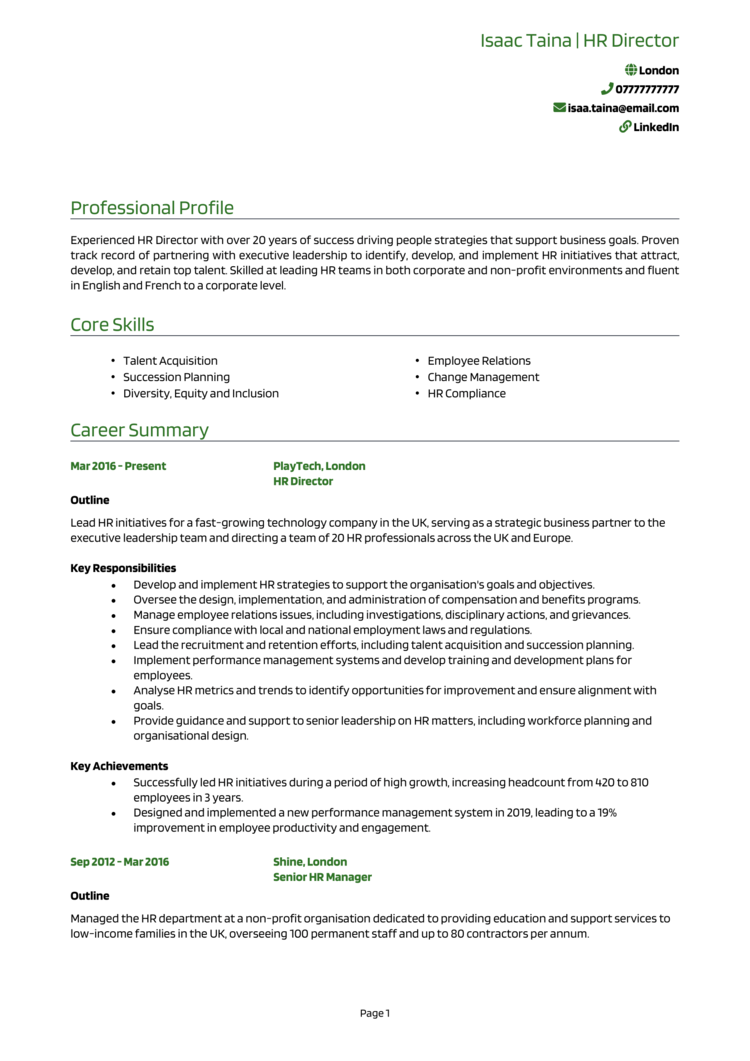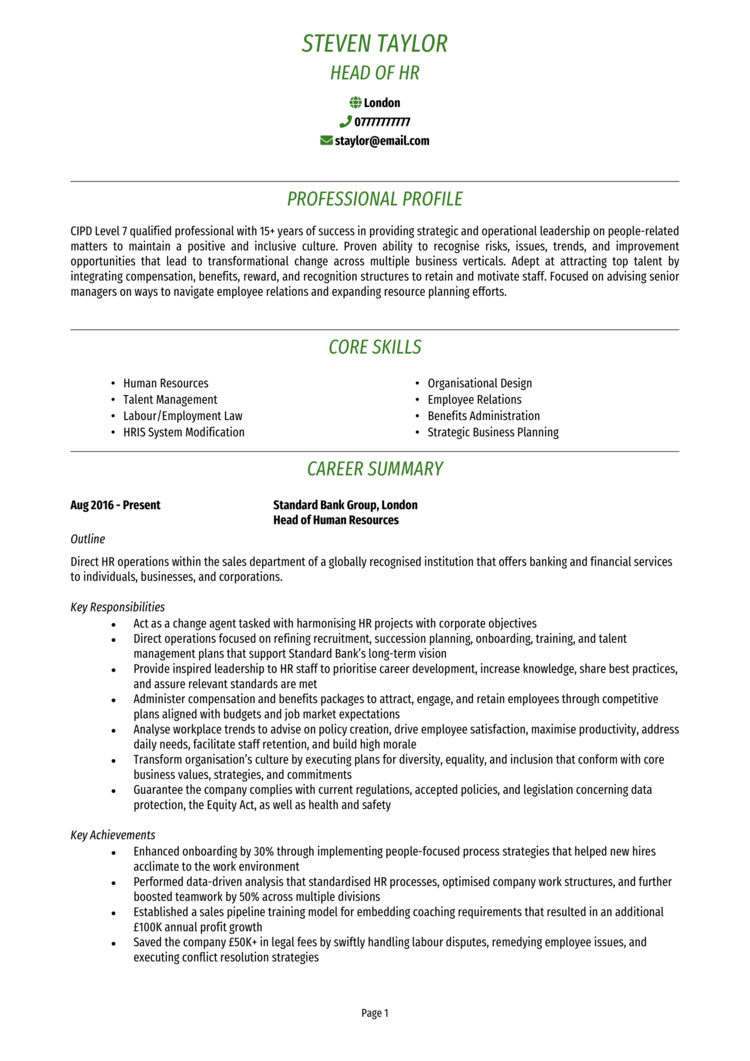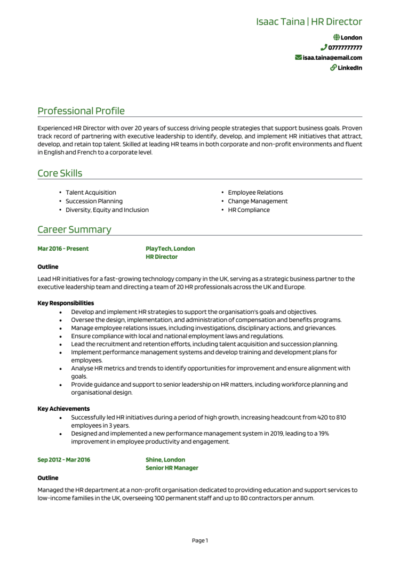You’ve handled restructures, led cultural transformations, and made “people strategy” more than just a buzzword. But when it comes to your own career, there’s still one document that needs careful alignment: your CV.
This guide will help you craft a polished, professional HR Director CV that showcases your strategic thinking and leadership expertise. With 2 HR Director CV examples and expert advice, you’ll learn how to present your credentials in a way that’s not just impressive – but relevant to the top roles you’re aiming for.
HR Director CV example

Head of HR CV example

How to write your HR Director CV
Discover how to craft a winning HR Director CV that lands interviews with this simple step-by-step guide.
At the HR Director level, your CV isn’t just about listing achievements – it’s about demonstrating vision and leadership. The content should make it clear that you drive business performance through people.
This guide walks through every section of your CV, helping you tailor each part to reflect your impact at the strategic level and writing a CV which positions you as a trusted boardroom contributor.
The best way to structure and format your HR Director CV


When applying for senior HR leadership roles, clarity and professionalism are essential. Your CV should feel like an executive summary – high-level and easy to navigate. If recruiters struggle to navigate through an unclear structure, they’re just going to move straight onto the next candidate: so make your expertise easy to understand.
Here’s the layout to follow:
- Name and contact details – Ensure your name and contact details are easily visible at the top. A photo is optional and depends on the role.
- Profile – Craft a short introduction that showcases your professional background and key accomplishments.
- Core skills – Provide a quick overview of your top skills that show why you’re a great fit.
- Work experience – Outline your career progression in reverse order, emphasising your contributions and successes.
- Education – Provide details on your academic background, including certifications or specialised training.
- Additional info – You can add hobbies or activities here that reflect your enthusiasm for the industry.
Use clean section headings to divide your content, and break up longer blocks of text using bullet points. Stick to a professional font and ensure your layout feels clean and spacious – white space can be just as impactful as content. Keep it two pages long, and focus every section on your business impact, not just your responsibilities. A well-presented CV format at this level signals both professionalism and communication skills.
What is a HR Director CV profile?


A well-written CV profile immediately positions you as a credible senior leader. It’s your chance to show that you understand people and business – and know how to align both to deliver results.
Use it to highlight your role in shaping organisational culture, leading through change, and supporting business growth through effective HR leadership. Recruiters should immediately understand what makes you the right fit, and see a reason to read the rest of your CV.
HR Director CV profile examples
Profile 1
Strategic HR Director with over 15 years of experience leading human resources functions for multinational corporations across the technology and manufacturing sectors. Strong track record in talent management, organisational development, and change leadership. Skilled in aligning HR strategy with business objectives and driving large-scale transformation.
Profile 2
Experienced HR Director with a background in scaling HR operations within fast-growing retail and e-commerce businesses. Proven expertise in workforce planning, leadership development, and employee relations. Adept at building high-performing HR teams and implementing modern people strategies to support growth and retention.
Profile 3
Results-driven HR Director with a decade of experience supporting organisational change, mergers, and culture integration in complex, matrixed environments. Strong knowledge of employment law, global mobility, and diversity & inclusion initiatives. Focused on delivering business value through people-focused leadership.
Details to put in your HR Director CV profile
Include the following:
- Where you worked – Mention the types of organisations you’ve led HR functions for – from global firms to fast-growth scale-ups or public sector bodies.
- Your top qualifications – Note any degrees, HR certifications, or chartered status with CIPD or SHRM.
- Essential skills – Point to your expertise in areas like transformation, employee engagement, or workforce planning.
- Strategic focus – Refer to your work influencing senior leadership, aligning HR to business goals, or leading enterprise-wide initiatives.
- Value delivered – Show how your leadership improved business outcomes – from staff retention to profitability or reputation.
How to highlight your core skills


At this level, your CV needs to communicate strategic ability, not just operational knowledge. The core skills section is where you show the depth and breadth of your capabilities – but the focus should remain on hard, tangible competencies that line up with the role specification.
Don’t list generic qualities here. Instead, concentrate on high-level expertise that’s expected of a board-ready HR leader, keeping it sharp and relevant to the needs of a modern organisation.
Essential skills for a HR Director CV
- Strategic Workforce Planning – Leading the development and execution of long-term talent strategies aligned with organisational goals.
- Leadership Development and Succession Planning – Designing initiatives to identify, develop, and retain high-potential leaders across the business.
- Organisational Design and Change Leadership – Driving structural changes, cultural transformation, and people initiatives to support business evolution.
- HR Policy and Compliance Oversight – Ensuring all HR practices comply with employment law, regulations, and internal governance frameworks.
- Executive Stakeholder Engagement – Advising C-suite executives and board members on people strategy, risk, and workforce performance.
- Performance Management Frameworks – Overseeing systems that align individual performance with business objectives through appraisals and KPIs.
- Diversity, Equity, and Inclusion Strategy – Leading inclusive hiring, training, and development practices that support a diverse workplace culture.
- Compensation and Benefits Strategy – Developing competitive reward structures that attract and retain top talent while managing cost efficiency.
- Employee Relations and Conflict Resolution – Managing complex employee issues, disputes, and negotiations at the executive level.
- HR Technology and Analytics Leadership – Leveraging HRIS systems and data analytics to inform decision-making and measure HR impact.
How to showcase your work experience in your CV


This section is where your leadership story comes through. Employers want to see what you’ve built, what you’ve transformed, and how you’ve led others through complexity. The focus here isn’t just on HR outputs – it’s on business outcomes.
Walk the reader through your work experience in reverse order, starting with your most recent. For each one, write a short paragraph summarising the company, the scope of your role, and your key reporting lines. Then use bullet points to describe your strategic contributions and achievements – particularly when tied to performance metrics or enterprise-wide initiatives.
How to format previous jobs in your CV correctly

- Outline – Give an overview of your role, the size and structure of the company, and the scope of your responsibilities. Include any board-level collaboration.
- Responsibilities – Use action words like “led” and “orchestrated.” For example: “led global talent strategy across 14 countries” or “orchestrated HR due diligence during a major acquisition.”
- Achievements – Highlight measurable results – reductions in turnover, improvements in engagement, cost savings, or accelerated growth tied to people strategy. Use numbers wherever possible.
Example work history for HR Directors
HR Director | Merivale Engineering Group
Outline
Led the HR function for a 1,200-employee engineering and manufacturing business operating across four UK sites.
Responsibilities
- Developed and implemented a new five-year people strategy aligned with company objectives
- Oversaw all HR operations including recruitment, L&D, employee relations, and performance management
- Advised senior leadership on succession planning, pay structures, and workforce forecasting
- Managed a team of 10 HR professionals and external service providers
- Led negotiations with trade unions during policy and contract updates
Achievements
- Reduced voluntary turnover by 22% through a revamped retention strategy
- Successfully led HR workstream during site consolidation and organisational restructure
- Introduced a leadership development programme adopted across three business units
Head of HR | Axora Lifestyle Retail Group
Outline
Directed all HR functions for a growing high-street and online retail brand with 800+ staff across the UK and Ireland.
Responsibilities
- Designed and rolled out a group-wide talent management framework and onboarding experience
- Standardised HR policies across retail, warehousing, and corporate divisions
- Collaborated with department heads to address workforce planning and seasonal resourcing
- Championed DE&I programmes and improved internal reporting practices
- Oversaw internal communications during times of operational change
Achievements
- Increased internal promotion rate by 35% through new talent pipeline initiatives
- Reduced average time-to-hire from 29 to 18 days through process optimisation
- Achieved 96% compliance on HR audits across multiple retail locations
HR Lead | Veltrix Financial Services
Outline
Managed global HR operations for a financial services provider with teams in London, Dublin, and Frankfurt.
Responsibilities
- Led organisational design projects following expansion into new markets
- Oversaw employee engagement and culture strategies across all sites
- Advised C-suite on global mobility, benefits benchmarking, and workforce risks
- Directed delivery of annual pay review, bonus, and performance processes
- Supported HRIS upgrades and implementation of new payroll system
Achievements
- Enabled smooth post-merger integration of 400 staff through clear communication planning
- Introduced mental health and wellbeing support that reached 85% staff engagement
- Streamlined HR reporting processes, saving 250+ hours annually across the HR function
Structuring your education section


At HR Director level, formal qualifications help reinforce your credibility – especially if you’re applying to regulated or multinational organisations. Include your degree(s) along with any postgraduate HR training, leadership programmes, or relevant certifications.
Write your education section clearly and concisely, without listing every module. If you’re chartered with the CIPD or a member of another governing body, include it here too.
Top qualifications to showcase on a HR Director CV
- Chartered CIPD (Chartered Fellow or Chartered Member) – Demonstrates senior-level credibility and compliance with HR standards
- MBA or MSc in HR Management – Combines leadership and strategic thinking with people management
- SHRM-SCP (Senior Certified Professional) – Globally recognised senior HR certification
- ILM Level 7 in Leadership and Management – Supports executive-level leadership ability
- Degree in HRM, Business, or Organisational Psychology – A solid academic foundation for understanding people and strategy





